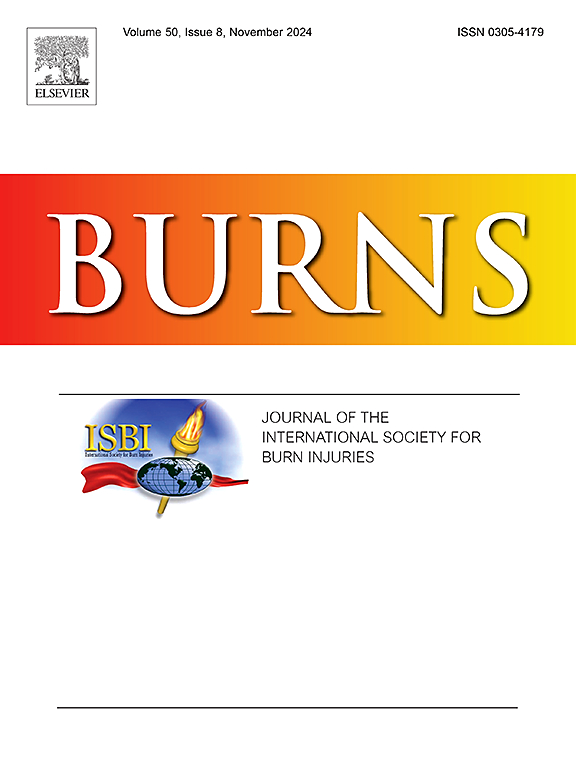资源支持优化恢复(RESTORE)范围审查:评估烧伤幸存者的善后资源。
IF 3.2
3区 医学
Q2 CRITICAL CARE MEDICINE
引用次数: 0
摘要
背景:烧伤幸存者报告说,他们在初次住院后过渡到社区时资源有限。这个项目的目的是回顾文献,确定提供给烧伤幸存者和他们的支持者出院后的社区资源。方法:采用系统评价和荟萃分析首选报告项目(PRISMA)指南检查以下文献数据库:PubMed、EMBASE、Web of Science、PsycInfo和CINAHL。世界卫生组织(世卫组织)国际功能、残疾和健康分类(ICF)烧伤核心集提供了对资源内容进行分类的框架。结果:在筛选的637篇文章中,27篇符合纳入标准。数据提取将资源分类为以下ICF组成部分:身体功能、活动和参与以及环境因素。结论:本综述使用了一个概念框架,概述了目前发表的支持住院后烧伤幸存者的资源。已确定的资源涉及诸如卫生专业人员、项目、烧伤后的心理功能、疤痕管理和虚拟资源等内容。基于ICF框架,注意到资源含量方面的一些差距,如疼痛、体温调节、人际关系和自我保健。研究结果揭示了资源的相对优势和差距,可用于更好地支持住院后的烧伤幸存者。本文章由计算机程序翻译,如有差异,请以英文原文为准。
REsource Support To Optimize REcovery (RESTORE) scoping review: Evaluating aftercare resources for burn survivors
Background
Burn survivors report limited resources as they transition to their communities after initial hospitalization. The aim of this project is to review literature that identifies resources provided to burn survivors and their supporters after discharge to their communities.
Methods
The Preferred Reporting Items for Systematic reviews and Meta-Analyses (PRISMA) guidelines were used to examine the following literature databases: PubMed, EMBASE, Web of Science, PsycInfo, and CINAHL. The World Health Organization (WHO) International Classification of Functioning, Disability and Health (ICF) Core Set for burn injury provided a framework to categorize resource content.
Results
Of the 637 articles screened, 27 met inclusion criteria. Data extraction identified resources categorized into the following ICF components: Body Functions, Activities and Participation, and Environmental Factors.
Conclusion
This review uses a conceptual framework to provide an overview of current published resources to support burn survivors following hospitalization. The identified resources addressed content such as health professionals, programs, psychological functioning after burn injury, scar management, and virtual resources. Based on the ICF framework, some gaps in resource content were noted such as pain, thermoregulation, interpersonal relationships, and self-care. Findings reveal relative strengths and gaps in resources, which can be used to better support burn survivors following hospitalization.
求助全文
通过发布文献求助,成功后即可免费获取论文全文。
去求助
来源期刊

Burns
医学-皮肤病学
CiteScore
4.50
自引率
18.50%
发文量
304
审稿时长
72 days
期刊介绍:
Burns aims to foster the exchange of information among all engaged in preventing and treating the effects of burns. The journal focuses on clinical, scientific and social aspects of these injuries and covers the prevention of the injury, the epidemiology of such injuries and all aspects of treatment including development of new techniques and technologies and verification of existing ones. Regular features include clinical and scientific papers, state of the art reviews and descriptions of burn-care in practice.
Topics covered by Burns include: the effects of smoke on man and animals, their tissues and cells; the responses to and treatment of patients and animals with chemical injuries to the skin; the biological and clinical effects of cold injuries; surgical techniques which are, or may be relevant to the treatment of burned patients during the acute or reconstructive phase following injury; well controlled laboratory studies of the effectiveness of anti-microbial agents on infection and new materials on scarring and healing; inflammatory responses to injury, effectiveness of related agents and other compounds used to modify the physiological and cellular responses to the injury; experimental studies of burns and the outcome of burn wound healing; regenerative medicine concerning the skin.
 求助内容:
求助内容: 应助结果提醒方式:
应助结果提醒方式:


